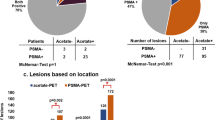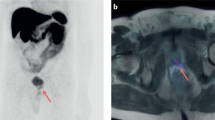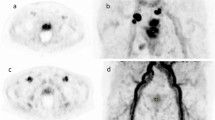Abstract
Background
The aim of the study was to prospectively evaluate diagnostic performance of 18F-PSMA-1007 PET/CT in patients with prostate cancer (PCa) after radical treatment and low but rising prostate-specific antigen (PSA) levels.
Methods
We prospectively enrolled 40 consecutive patients after radical treatment (80%—radical prostatectomy, 20%—radiation beam therapy) of PCa and low (0.008 to ≤2.0 ng/ml), rising PSA. Skull to mid-thigh PET/CT imaging was performed 95 (±12) min after injection of 295.5 (±14.1) MBq 18F-PSMA-1007. Detection rate was correlated with PSA levels, Gleason score (GS) and T stage ≥ 3. PET/CT results were verified during 10.3 (±4.7) months follow-up to calculate sensitivity, specificity, negative predictive values (NPV) and positive predictive values (PPV).
Results
18F-PSMA-1007 PET/CT was positive in 24/40 patients, which yielded overall detection rate of 60%. Detection rate was 39%, 55% and 100% for PSA < 0.5, 0.5 to <1.0 and 1.0 to ≤2.0 ng/ml, respectively. PET/CT showed metastases in locoregional lymph nodes in 55% of patients, bones in 36% of patients and local recurrence in 9% of patients. Detection rate was correlated with PSA—a 0.1 ng/ml rise in PSA level increased odds for positive PET/CT by ~30%. PET/CT positivity was independent of GS and T stage. Verification of 40 lesions yielded sensitivity, specificity, PPV and NPV of 100%, 94.4%, 66.7% and 100%, respectively.
Conclusions
18F-PSMA-1007 PET/CT shows relatively high detection rate in patients with PCa after radical treatment and low, rising PSA levels. Like other PSMA-targeting radiotracers, its detection rate is dependent on PSA levels. 18F-PSMA-1007 also presents excellent sensitivity, specificity and NPV.
This is a preview of subscription content, access via your institution
Access options
Subscribe to this journal
Receive 4 print issues and online access
$259.00 per year
only $64.75 per issue
Buy this article
- Purchase on Springer Link
- Instant access to full article PDF
Prices may be subject to local taxes which are calculated during checkout

Similar content being viewed by others
References
Cornford P, Bellmunt J, Bolla M, Briers E, De Santis M, Gross T, et al. EAU-ESTRO-SIOG guidelines on prostate cancer. Part II: treatment of relapsing, metastatic, and castration-resistant prostate cancer. Eur Urol. 2017;71:630–42.
Stish BJ, Pisansky TM, Harmsen WS, Davis BJ, Tzou KS, Choo R, et al. Improved metastasis-free and survival outcomes with early salvage radiotherapy in men with detectable prostate-specific antigen after prostatectomy for prostate cancer. J Clin Oncol J Am Soc Clin Oncol. 2016;34:3864–71.
Siegmann A, Bottke D, Faehndrich J, Brachert M, Lohm G, Miller K, et al. Salvage radiotherapy after prostatectomy—what is the best time to treat? Radiother Oncol J Eur Soc Ther Radio Oncol. 2012;103:239–43.
Wiegel T, Lohm G, Bottke D, Höcht S, Miller K, Siegmann A, et al. Achieving an undetectable PSA after radiotherapy for biochemical progression after radical prostatectomy is an independent predictor of biochemical outcome–results of a retrospective study. Int J Radiat Oncol Biol Phys. 2009;73:1009–16.
Cardinale J, Schäfer M, Benešová M, Bauder-Wüst U, Leotta K, Eder M, et al. Preclinical evaluation of 18F-PSMA-1007, a new prostate-specific membrane antigen ligand for prostate cancer imaging. J Nucl Med Publ Soc Nucl Med. 2017;58:425–31.
Giesel FL, Knorr K, Spohn F, Will L, Maurer T, Flechsig P, et al. Detection efficacy of 18F-PSMA-1007 PET/CT in 251 patients with biochemical recurrence of prostate cancer after radical prostatectomy. J Nucl Med Publ Soc Nucl Med. 2019;60:362–8.
Rahbar K, Afshar-Oromieh A, Seifert R, Wagner S, Schäfers M, Bögemann M, et al. Diagnostic performance of 18F-PSMA-1007 PET/CT in patients with biochemical recurrent prostate cancer. Eur J Nucl Med Mol Imaging. 2018;45:2055–61.
Rahbar K, Afshar-Oromieh A, Bögemann M, Wagner S, Schäfers M, Stegger L, et al. 18F-PSMA-1007 PET/CT at 60 and 120 min in patients with prostate cancer: biodistribution, tumour detection and activity kinetics. Eur J Nucl Med Mol Imaging. 2018;45:1329–34.
Robu S, Schmidt A, Eiber M, Schottelius M, Günther T, Hooshyar Yousefi B, et al. Synthesis and preclinical evaluation of novel 18F-labeled Glu-urea-Glu-based PSMA inhibitors for prostate cancer imaging: a comparison with 18F-DCFPyl and 18F-PSMA-1007. EJNMMI Res. 2018;8:30.
Afshar-Oromieh A, Avtzi E, Giesel FL, Holland-Letz T, Linhart HG, Eder M, et al. The diagnostic value of PET/CT imaging with the (68)Ga-labelled PSMA ligand HBED-CC in the diagnosis of recurrent prostate cancer. Eur J Nucl Med Mol Imaging. 2015;42:197–209.
Eiber M, Maurer T, Souvatzoglou M, Beer AJ, Ruffani A, Haller B, et al. Evaluation of hybrid 68Ga-PSMA ligand PET/CT in 248 patients with biochemical recurrence after radical prostatectomy. J Nucl Med Publ Soc Nucl Med. 2015;56:668–74.
Rowe SP, Campbell SP, Mana-Ay M, Szabo Z, Allaf ME, Pienta KJ, et al. Prospective evaluation of PSMA-targeted 18F-DCFPyL PET/CT in men with biochemical failure after radical prostatectomy for prostate cancer. J Nucl Med Off Publ Soc Nucl Med. 2019.
Detti B, Scoccianti S, Franceschini D, Cipressi S, Cassani S, Villari D, et al. Predictive factors of [18F]-Choline PET/CT in 170 patients with increasing PSA after primary radical treatment. J Cancer Res Clin Oncol. 2013;139:521–8.
Hope TA, Goodman JZ, Allen IE, Calais J, Fendler WP, Carroll PR. Metaanalysis of 68Ga-PSMA-11 PET accuracy for the detection of prostate cancer validated by histopathology. J Nucl Med Publ Soc Nucl Med. 2019;60:786–93.
Dyrberg E, Hendel HW, Huynh THV, Klausen TW, Løgager VB, Madsen C, et al. 68Ga-PSMA-PET/CT in comparison with 18F-fluoride-PET/CT and whole-body MRI for the detection of bone metastases in patients with prostate cancer: a prospective diagnostic accuracy study. Eur Radiol. 2019;29:1221–30.
Hamed MAG, Basha MAA, Ahmed H, Obaya AA, Afifi AHM, Abdelbary EH. 68Ga-PSMA PET/CT in patients with rising prostatic-specific antigen after definitive treatment of prostate cancer: detection efficacy and diagnostic accuracy. Acad Radiol. 2019;26:450–60.
Author information
Authors and Affiliations
Corresponding author
Ethics declarations
Conflict of interest
The authors declare that they have no conflict of interest.
Additional information
Publisher’s note Springer Nature remains neutral with regard to jurisdictional claims in published maps and institutional affiliations.
Rights and permissions
About this article
Cite this article
Witkowska-Patena, E., Giżewska, A., Dziuk, M. et al. Diagnostic performance of 18F-PSMA-1007 PET/CT in biochemically relapsed patients with prostate cancer with PSA levels ≤ 2.0 ng/ml. Prostate Cancer Prostatic Dis 23, 343–348 (2020). https://doi.org/10.1038/s41391-019-0194-6
Received:
Revised:
Accepted:
Published:
Issue Date:
DOI: https://doi.org/10.1038/s41391-019-0194-6
This article is cited by
-
The superior detection rate of total-body [68Ga]Ga-PSMA-11 PET/CT compared to short axial field-of-view [68Ga]Ga-PSMA-11 PET/CT for early recurrent prostate cancer patients with PSA < 0.2 ng/mL after radical prostatectomy
European Journal of Nuclear Medicine and Molecular Imaging (2024)
-
Assessment of malignancy and PSMA expression of uncertain bone foci in [18F]PSMA-1007 PET/CT for prostate cancer—a single-centre experience of PET-guided biopsies
European Journal of Nuclear Medicine and Molecular Imaging (2022)
-
Preclinical development of a novel [68Ga]Ga-/[177Lu]Lu-labeled agent for PSMA-targeted imaging and therapy
Journal of Radioanalytical and Nuclear Chemistry (2022)
-
Diagnostic accuracy of [18F]PSMA-1007 PET/CT in biochemical recurrence of prostate cancer
European Journal of Nuclear Medicine and Molecular Imaging (2022)
-
Parameters predicting [18F]PSMA-1007 scan positivity and type and number of detected lesions in patients with biochemical recurrence of prostate cancer
EJNMMI Research (2021)



